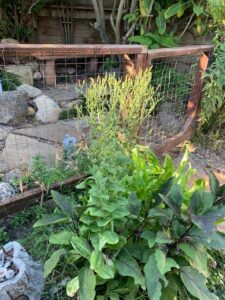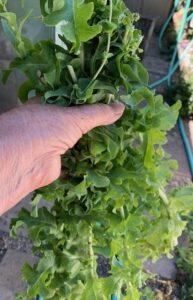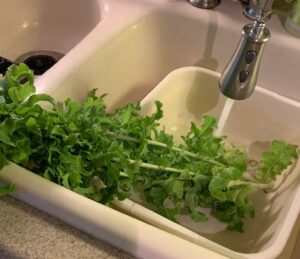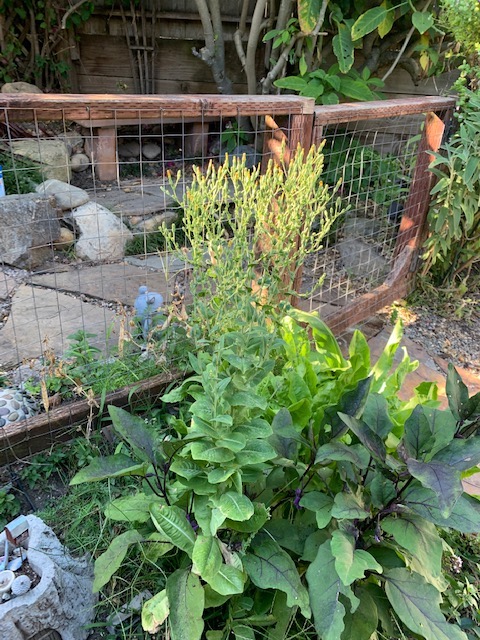
Help! My Lettuce is Bolting.
The heatwave that hit Santa Cruz recently fried my chard leaves and caused the leaf lettuce to bolt. Looking at the gangly plants, overnight grown to four feet in height, I wondered why we call this sudden growth “bolting.” I sat in the shade and reached for my smartphone.
“Run away suddenly, out of control”
The word “bolt,” it turns out, can mean many things. My online dictionary listed six definitions of bolt used as a noun: a roll of fabric; a bar that slides into a socket to fasten a door or window; a threaded pin that screws into a nut and is used to fasten things together; a long pin that is driven into a rock face so that a rope can be attached to it; a short, heavy arrow shot from a crossbow; and a jagged white flash of lightning.
I had to search further for the verbs: (of a horse or other animal) run away suddenly out of control; (of a person) move or run away suddenly; (in hunting) cause (a rabbit or fox) to run out of its burrow or hole; eat or swallow (food) quickly; and, finally, (of a plant) grow tall quickly and stop flowering as seeds develop. The example given for the last definition was, ironically, “the lettuces have bolted.”
 A Second Chance?
A Second Chance?
Sadly, I began to pull up the lettuce. Six different plants had been providing me with daily salad greens. When I saw them all lying in a pile, headed for the compost heap, I felt I had failed the spunky little plants. Impulsively, I hacked off the root ball and seed tops of one. Then another, and another. I picked off a couple of leaves and tasted them. Not bitter. Smiling, I rinsed the plants with the hose and took them inside, setting their root ends in a tub of water while I finished my gardening chores.
When I returned to the kitchen, I stripped the leaves off the fibrous stems just like I strip herb leaves from theirs. The lettuce released the leaves easily.
Next, I soaked the lettuce in cold water. There were enough leaves to fill my dishpan three times. After drying the leaves in a salad spinner, I put them in three plastic bags to crisp up. That night I made my first salad with the rescued Lactuca sativa. The leaves were tender and sweet.
Success! 
I don’t know for sure how long they will last in the refrigerator, but I’m hoping these tasty greens will stay fresh until the six new plants I put in today are ready to harvest.
Do you have any success stories from the garden? Please share them with us in the comment section — we all need happy endings about now.
Marlene Bumgarner is a writer, college instructor, grandma, and companion to Kismet, her sweet Border Collie. Her new memoir, Back to the Land in Silicon Valley, chronicles her adventures and challenges of living on the land in the 1970s. She enjoys writing, cooking, gardening, and reading bedtime stories to her grandchildren on FaceTime or Zoom. She also loves reading your comments, which can be posted below.
Share this post




Why don’t you make some lettuce soup? I read a recipe for it a while ago & it sounded delicious and cooling.
What a good idea! By the time I get back to Santa Cruz the second crop of lettuce will probably have bolted, too!
Once washed, as long as leaves are dried before sealing the bag and bag is checked each day or so to drain off any moisture that may collect, I’ve had leaves last several days…up to a week in some cases. Good rescue!
Good suggestion! Thank you, Barbara.